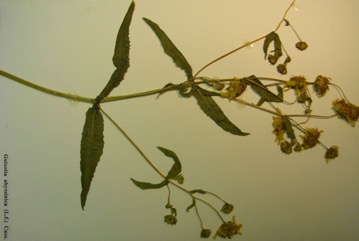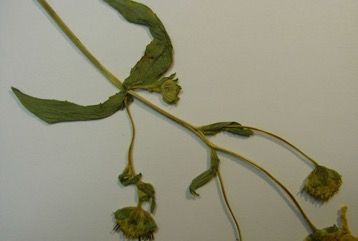Niger Seed

It is grown in both temperate and tropical zones. It can compete well with weeds. It has some salt tolerance. The temperatures are between 16°C and 20°C where Niger does best. It cannot tolerate temperatures above 28°C average and must have temperatures above 6°C. In Africa it grows between 300 and 2300 m altitude but does best at 1800-2000 m altitude in Ethiopia. The rainfall is 100-1300 mm per year where it grows most. At lower altitudes a lower rainfall is satisfactory if it is spread through the growing season. It grows on a wide range of soils. It can grow on poorly drained soils. It needs short day lengths for flowering. In Nepal it grows between 900-2000 m altitude. It grows in open places. It can grow in arid places. Tasmania Herbarium. In Sichuan and Yunnan.
Also known as:
Alashi, Gizkoa, Gurellu, Huchellu, Jhuse til, Kadellu, Kalatel, Kalatil, Karale, Khurasni, Khurosui, Negrillo, Neuk, Nigersaat, Noog, Nook Abessin, Nuga, Nughi, Nughio, Nuk, Pan-hnan, Payellu, Philunge, Rameli, Ramtal, Ramtil, Ramtilla, Sarguza, Sorguja, Surguja, Uchellu, Verrinuvvulu
Synonyms
- Guizotia oleifera DC.
- Jaegeria abyssinica (L.f.) Spreng.
- Polymnia abyssinica L.f.
- Ramtilla oleifera DC.
- Vernesina sativa Roxb. ex Sims
Edible Portion
- Seeds, Leaves, Oil, Vegetable
Where does Niger Seed grow?
Found in: Africa, Asia, Australia, Bangladesh, Bhutan, Britain, Cameroon, Canada, Central Africa, China, Congo, Czech Republic, East Africa, Eritrea, Ethiopia, Germany, Ghana, Himalayas, India, Italy, Kenya, Malawi, Myanmar, Nepal, North America, Northeastern India, Pakistan, SE Asia, Sikkim, Slovakia, Southern Africa, Spain, Sudan, Tanzania, Tasmania, Uganda, United States, West Africa, West Indies, Zimbabwe
Notes: The seeds have good food value.
Status: It is a cultivated food plant. About 300,000 tons per year of oil are produced in Ethiopia and India.
Growing Niger Seed
Cultivation: It is grown from seed. It is often sown mixed with finger millet. Seeds can be broadcast or planted in rows. 10-15 kg of seed per hectare are used for broadcast crops. When planted in rows 5-8 kg per hecatre of seed are used. Fertilisers do not improve seed yield much. As petals drop, seeds are harvested to avoid seed loss. Stems are cut near the ground, then dried for a few days before threshing.
Edible Uses: The seeds can be fried and used as snacks. They are also used in sauces. They are also used for chutney and pickles. The seed cake is mixed with honey to make a sweet bread. The seed oil is edible. It is used in cooking.
Production: Flowering occurs 3 months after sowing. Seeds are ready for harvest 4-6 weeks later. It can take 5 months at altitudes over 2000 m. Yields can be 300-700 kg per hectare. Yields of 1400 kg are possible.
Nutrition Info
per 100g edible portion| Edible Part | Energy (kcal) | Protein (g) | Iron (mg) | Vitamin A (ug) | Vitamin c (mg) | Zinc (mg) | % Water |
|---|---|---|---|---|---|---|---|
| Seed | 483 | 17.3 | - | - | - | - | 6.2 |
Niger Seed Photos


References
Ambasta, S.P. (Ed.), 2000, The Useful Plants of India. CSIR India. p 250
Arora, R. K., 2014, Diversity in Underutilized Plant Species - An Asia-Pacific Perspective. Bioversity International. p 112
Bandyopadhyay, S. et al, 2009, Wild edible plants of Koch Bihar district, West Bengal. Natural Products Radiance 8(1) 64-72
Bianchini, F., Corbetta, F., and Pistoia, M., 1975, Fruits of the Earth. Cassell. p 238
Brouk, B., 1975, Plants Consumed by Man. Academic Press, London. p 235
Bulcha, W., 2007. Guizotia abyssinica (L.f.) Cass. [Internet] Record from Protabase. van der Vossen, H.A.M. & Mkamilo, G.S. (Editors). PROTA (Plant Resources of Tropical Africa), Wageningen, Netherlands. < http://database.prota.org/search.htm>. Accessed 16 October 2009.
Burkill, H. M., 1985, The useful plants of west tropical Africa, Vol. 1. Kew.
Cobley, L.S. (rev. Steele, W.M.) 2nd Ed., 1976, An Introduction to the Botany of Tropical Crops. Longmans. p 294
F. Cuvier, Dict. sci. nat. 59:248. 1829
Dangol, D. R. et al, 2017, Wild Edible Plants in Nepal. Proceedings of 2nd National Workshop on CUAOGR, 2017.
Facciola, S., 1998, Cornucopia 2: a Source Book of Edible Plants. Kampong Publications, p 38
FAO, 1988, Traditional Food Plants, FAO Food and Nutrition Paper 42. FAO Rome p 315
GAMMIE
Getinet, A. and S.M. Sharma. 1996. Niger. Guizotia abyssinica (L. f.) Cass. Promoting the conservation and use of underutilized and neglected crops. 5. Institute of Plant Genetics and Crop Plant Research, Gatersleben/International Plant Genetic Re-sources Institute, Rome.
Grubben, G. J. H. and Denton, O. A. (eds), 2004, Plant Resources of Tropical Africa 2. Vegetables. PROTA, Wageningen, Netherlands. p 562
Hedrick, U.P., 1919, (Ed.), Sturtevant's edible plants of the world. p 335
Jardin, C., 1970, List of Foods Used In Africa, FAO Nutrition Information Document Series No 2.p 43
Kiple, K.F. & Ornelas, K.C., (eds), 2000, The Cambridge World History of Food. CUP p 1823
Lazarides, M. & Hince, B., 1993, Handbook of Economic Plants of Australia, CSIRO. p 126
Manandhar, N.P., 2002, Plants and People of Nepal. Timber Press. Portland, Oregon. p 252
Menninger, E.A., 1977, Edible Nuts of the World. Horticultural Books. Florida p 103
Molla, A., Ethiopian Plant Names. http://www.ethiopic.com/aplants.htm
Plants for a Future database, The Field, Penpol, Lostwithiel, Cornwall, PL22 0NG, UK. http://www.scs.leeds.ac.uk/pfaf/
Polunin, O., & Stainton, A., 2006, Flowers of the Himalaya, Oxford India Paperbacks. p 188
Purseglove, J.W., 1968, Tropical Crops Dicotyledons, Longmans. p 65
Rashid, H. E., 1977, Geography of Bangladesh. Westview. p 290 (As Guizotia abysinaica)
Royal Botanic Gardens, Kew (1999). Survey of Economic Plants for Arid and Semi-Arid Lands (SEPASAL) database. Published on the Internet; http://www.rbgkew.org.uk/ceb/sepasal/internet [Accessed 11th April 2011]
Rubaihayo, E. B., Conservation and use of traditional vegetables in Uganda. Bioversity International.
Savita, et al, 2006, Studies on wild edible plants of ethnic people in east Sikkim. Asian J. of Bio Sci. (2006) Vol. 1 No. 2 : 117-125
Seidemann J., 2005, World Spice Plants. Economic Usage, Botany, Taxonomy. Springer. p 171
Smith, P.M., 1979, Niger seed, in Simmonds, N.W., (ed), Crop Plant Evolution. Longmans. London. p 305
van Wyk, B., 2005, Food Plants of the World. An illustrated guide. Timber press. p 205
Vickery, M.L. and Vickery, B., 1979, Plant Products of Tropical Africa, Macmillan. p 33
World Checklist of Useful Plant Species 2020. Royal Botanic Gardens, Kew